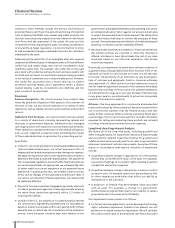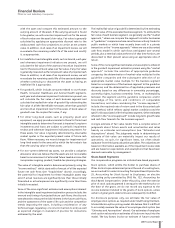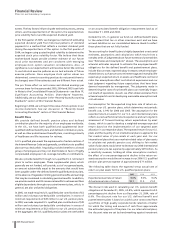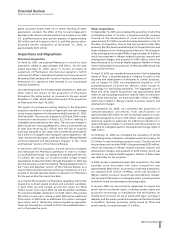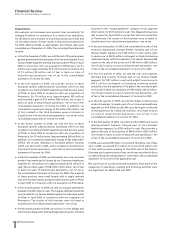Pfizer 2005 Annual Report Download - page 17
Download and view the complete annual report
Please find page 17 of the 2005 Pfizer annual report below. You can navigate through the pages in the report by either clicking on the pages listed below, or by using the keyword search tool below to find specific information within the annual report.
16 2005 Financial Report
Financial Review
Pfizer Inc and Subsidiary Companies
(income)/deductions—net; $73 million in write-offs of inventory
and exit costs, included in Cost of sales; $8 million related to
the costs of administering the suspension of sales, included in
Selling, informational and administrative expenses; and $212
million for an estimate of customer returns, primarily included
against Revenues.
•Zithromax, whose composition of matter patent in the U.S.
expired in November 2005, remained the number-one
prescribed oral antibiotic during 2005, despite the end of active
sales promotion in July, when the U.S. sales force began
promoting Zmax. During the fourth quarter of 2005, four
generic versions of oral solid azithromycin were launched,
including one authorized generic by Pfizer’s Greenstone
subsidiary. The generics launched two weeks later than
expected, which led to higher than expected sales of Zithromax
in the fourth quarter of 2005. After seven weeks of generic
availability, generic azithromycin constituted 90% of the total
oral solid azithromycin adult prescription volume. Pfizer’s
generic had captured 49% of total generic prescriptions.
•Zmax, a single-dose, sustained-release form of azithromycin for
adults, was introduced in the U.S. in August 2005 for treatment
of mild-to-moderate acute bacterial sinusitis and community-
acquired pneumonia in adult patients appropriate for oral
therapy due to susceptible pathogens. Single-dose Zmax delivers
higher azithromycin serum concentrations during the first 24
hours than Zithromax and assures complete compliance
compared to multi-dose regimes, demonstrating a clear benefit
of the new medication.
•Diflucan is a systemic antifungal. The decrease in sales in 2005
compared to 2004 is mainly due to loss of exclusivity in the U.S.
in July 2004.
•Viagra remains the leading treatment for erectile dysfunction
and one of the world’s most recognized pharmaceutical brands,
with more than 60% of U.S. sales in its market of
phosphodiesterase-5 (PDE5) inhibitors through November 2005.
2005 Viagra sales declined 2% worldwide from 2004, reflecting
aggressive competition, as well as negative growth for oral
erectile dysfunction treatments in several major markets. We
expect to see continued pressure on sales in the U.S. More
than 35 states have enacted “Preferred Drug Lists” that have
the potential to limit Pfizer sales to state Medicaid programs
and Medicare coverage will end in 2007. Effective January 1,
2006, federal funds may not be used for reimbursement of
erectile dysfunction medications by the Medicaid program.
Pfizer has begun to introduce new branded advertising
compliant with our DTC advertising guidelines to highlight the
unique clinical profile for Viagra, as well as new unbranded
advertising to address the needs of potential new patients who
may be hesitant to try any medication for erectile dysfunction.
On July 8, 2005, the FDA approved an update to the Viagra label
to reflect rare post-marketing reports of non-arteritic anterior
ischemic optic neuropathy (NAION) in patients taking PDE5
inhibitor medications. The updated label notes that in rare
instances, men taking PDE5 inhibitors, including Viagra,
reported a sudden decrease or loss of vision in one or both eyes
and that it is not possible to determine whether these events
are related directly to these medicines, to the patient’s
underlying vascular risk factors, to a combination of these
factors, or other factors. Most of the reported NAION cases
occurred in Viagra users with underlying anatomic or vascular
risk factors associated with the development of NAION.
•Camptosar is a semisynthetic camptothecin derivative that
works by inhibiting the topoisomerase 1 enzyme, which is
involved in cancer cell replication. Camptosar is indicated as first-
line therapy for metastatic colorectal cancer in combination with
5-fluorouracil and leucovorin. It is also indicated as second-line
therapy for patients in whom metastatic colorectal cancer has
recurred or progressed despite following initial fluorouracil-
based therapy. Camptosar is for intravenous use only. Revenue
growth of 64% in 2005 compared to 2004 was impacted in part
by Pfizer’s acquisition of marketing rights to Campto/Camptosar
in Europe and Asia (except Japan) in late 2004. Among current
oncology medications, the National Comprehensive Cancer
Network, an alliance of 19 of the world’s leading cancer centers,
has issued guidelines recommending Camptosar as an option
across all lines of treatment for advanced colorectal cancer.
•Xalatan/Xalacom, a prostaglandin analogue used to lower the
intraocular pressure associated with glaucoma and ocular
hypertension, is the most-prescribed branded glaucoma
medicine in the world. Clinical data showing its advantages in
treating intra-ocular pressure compared with beta blockers
should support the continued growth of this important
medicine. Xalacom, the only fixed combination prostaglandin
(Xalatan) and beta blocker, is available primarily in European
markets. In 2005, Xalatan/Xalacom experienced sales growth of
12% compared to 2004.
•Zyrtec provides strong, rapid and long-lasting relief for seasonal
and year-round allergies and hives with once-daily dosing.
Zyrtec continues to be the most-prescribed antihistamine in the
U.S. in a challenging market. The increase in sales in 2005
compared to 2004 is attributable to stabilization in the
prescription antihistamine market subsequent to the Rx to
over-the-counter switch of loratadine as the majority of the
managed care plans have completed their formulary tier
changes in this category.
•Caduet, a single pill combining Lipitor and Norvasc, has
successfully completed the Mutual Recognition Procedure
(MRP) in the E.U. and is the first multi-target combination
product to receive a broad approval for prevention of
cardiovascular events in the E.U. Caduet is now approved in the
following E.U. countries: France, Spain, Portugal, Austria,
Iceland, Luxembourg, Cyprus, the Czech Republic, Hungary,
Latvia, Lithuania, Malta, Poland, Slovakia and Slovenia. It is
indicated for prevention of cardiovascular events in
hypertensive patients with three concomitant cardiovascular risk
factors, normal to mildly elevated cholesterol levels, without
clinically evident coronary heart disease, where combined use
of amlodipine and low dose atorvastatin is considered
appropriate, and in accordance with current treatment
guidelines. The Caduet Marketing Authorization application has
been officially withdrawn from the MRP in Belgium, Denmark,
Estonia, Ireland, Italy, Netherlands, Norway, the U.K., Sweden,
Germany, Finland and Greece. These countries had reservations
as to whether the benefit of Caduet, the first cardiovascular,
multi-target, fixed combination product, had been
demonstrated, based upon current European regulatory
guidelines for fixed combination products. As a result, these
countries did not mutually recognize the proposed label and
Pfizer decided to withdraw the application from these countries.


